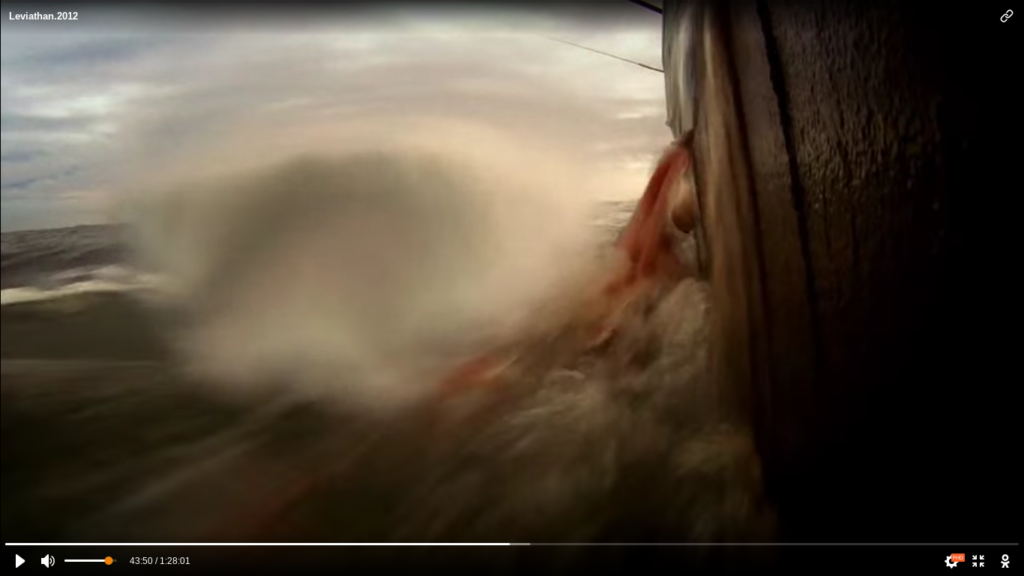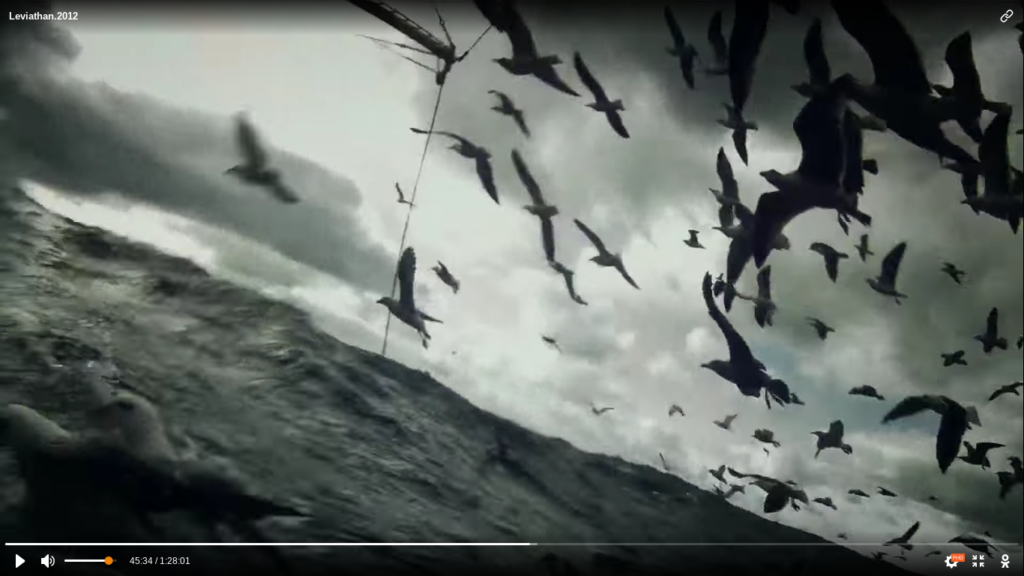In preparation for this lecture we watched the 2012 film Leviathan (Lucian Castaing-Taylor and Véréna Paravel). This takes the form of a documentary, focusing on the commercial fishing industry in the North Atlantic. Although watching this on the small screen of my phone, I was incredibly overwhelmed by its visuals, audio and superlative use of sensory material. The sounds of waves, the creaking boat, screeching birds and rattling chains overcharge any dialogue that can be heard in the film; audio input having the same weight as trustworthy voices around them. Adding to this maximal noise, we are seeing loud visuals from multiple angles that put us as an audience on the spot, witnessing this fishing trade, not as a human but as a separate entity. As shown in the below screenshots, the never-steady camera captures an essence of what it is like to be in this environment, showcasing its overloading elements and brutal nature of both being at sea and human brutality towards sea-life. After watching this film I felt nauseous, like I had just been on a boat that was moving up and down rapidly, my body feeling side effects of swift movement.



The first provocation Baxstrom introduced was CAN WE TAKE IT? ‘Sides’, being art and anthropology, are being interrogated in relation to one another here; are art audiences or anthropologists ready for this kind of confrontation? What happens if we are to put this into a gallery space and what are the ethics that would have to be thought about? Audiences here would be prepared but unsettled by this films content but, as theorised by George Bataille, individuals and collectives have differing notions of what limits are and where these limits can be tested.
Leviathan was made in collaboration with the Sensory Ethnography Lab which is an experimental laboratory that promotes innovative combinations of aesthetics and ethnography (1). But what is the need for this to exist? What purpose is there of categorising works such as this into art or anthropology and do we accept the fate of labelled works? This is an important question, and one that could not be agreed on in class, as this is how the work would be situated in the world, how it is talked about, publics it reaches, and even how it is viewed by us. Maybe its also important to remember that this is constantly shifting, depending on when something was created arguments continue rise and fall, resulting in a work like Leviathan to be constant flux as to where it belongs and how it should be viewed. Perhaps this is the role of art, in the art and anthropology question, as it adds the ambiguous potential to anthropological outputs, letting it reside in a space that is ambiguous and kinetic.
I have found with Leviathan, that although facts are not being dispersed within a dry documentary, this offers something to be learned. We are witnessing, through the films experimental nature also experiencing, what a trade is like that is out of reach, but also consumed, by most people. The Sensory Turn in anthropology adds a layer of imagery and emotion to a piece to make it more appealing to mass audiences and allow them to develop more of a connection to subjects. Questions of honesty arise from this: is this sensory experience needed to make this an ‘honest’ work or does honesty only arise out of highly methodological techniques and ethics involved? Even though the role of this film is to offer a sensory advantage point to the fishing industry, it is still framed by its creators therefore told through their set biases.
In Violence’s Fabled Experiment, films such as Leviathan play a transgressive role in this ‘third space’ that can expose the stakes of the world and bore deeply into our psyches, unearthing traces of what it means (or can mean) to be human (2). Content created in these films is being thrown back at us with an intention of questioning how and why we are watching it and what this can tell us about the human experience. Ethnographic thinking and cinema offers a portal to many worlds and is being adopted by an increasing amount of artists, Ethnography as anthropology’s main method and a means of entering, investigating but as well innovatively representing the world, is being advocated as a kind of link, a possibility encouraging artists and anthropologists “to learn directly from each other’s practices ‘in the field’(Schneider and Wright 2010). (3). This middle-ground offers the space to interrogate these relationships and discover the limits of what can be found here, answering earlier questions of whether each side ‘can take it.’
1 https://sel.fas.harvard.edu/
2 Violence’s Fabled Experiment. R. Baxstrom, T. Meyers.
3 Towards a New Hermeneutics of Art and Anthropology Collaborations. In Ethnoscripts, Art and Anthropology issue 17:1. A. Schneider. (2015).


Leave a Reply